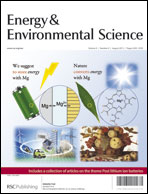Na-ion mobility in layered Na2FePO4F and olivine Na[Fe,Mn]PO4†
Abstract
The Na-ion battery is currently the focus of much research interest due to its cost advantages and the relative abundance of sodium as compared to lithium. Olivine NaMPO4 (M = Fe, Fe0.5Mn0.5, Mn) and layered Na2FePO4F are interesting materials that have been reported recently as attractive positive electrodes. Here, we report their Na-ion conduction behavior and intrinsic defect properties using atomistic simulation methods. In the olivines, Na ion migration is essentially restricted to the [010] direction along a curved trajectory, similar to that of LiMPO4, but with a lower migration energy (0.3 eV). However, Na/M antisite defects are also predicted to have a lower formation energy: the higher probability of tunnel occupation with a relatively immobile M2+
![Graphical abstract: Na-ion mobility in layered Na2FePO4F and olivine Na[Fe,Mn]PO4](/en/Image/Get?imageInfo.ImageType=GA&imageInfo.ImageIdentifier.ManuscriptID=C3EE40914G&imageInfo.ImageIdentifier.Year=2013)
- This article is part of the themed collection: Post lithium ion batteries

 Please wait while we load your content...
Please wait while we load your content...